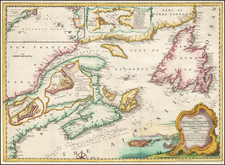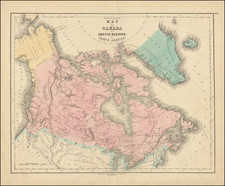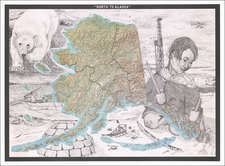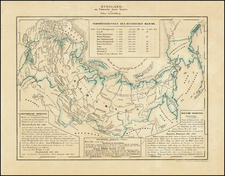Scarce map of the region around King George's Archipelago, from Seat Otter Bay to Behring's Bay, from the English edition Urey Lisiansky's Voyage Around The World in the Years 1803-1806, first published in Russian in 1812. Lisiansky's book is a very important..work on the history of Alaska in general and Sitka in particular. In command of the Neva, Lisianski accompanied Krusenstern on the first Russian circumnavigation, 1803-06. In 1804, he reached Kodiac, where he received word of the Kolosch massacre of the Russian-American Company's settlement at Sitka. While Krusenstern spent most of his time in Kamchatka, Lisianski crossed Sitka, and played a major role in Baranov's successful reoccupation of the Russian Fort and settlement. He spent over a year in Alaska, at Sitka, Kodiak and Norfolk Sound, where he made important scientific observations and conducted a detailed study of the native inhabitants and their customs. In the Pacific, Lisianski and Krusenstern separated at the Hawaiian Islands and followed different routes, Lisianski visiting Easter Island and the Marquesas, and discovering Lisianski Island in the Hawaiian chain. Abbey, Travel, 4. Arctic Bib. 10209. Hill p. 182. Howes L-372. Kroepelian 740. National Martime Museum I 150. Sabin 41416. Soliday I 873. Streeter VI 3507. Wickersham 6261. cfLada-Mocarski 68. A nice example in original color.
The Arrowsmiths were a cartographic dynasty which operated from the late-eighteenth century to the mid-nineteenth. The family business was founded by Aaron Arrowsmith (1750-1823), who was renowned for carefully prepared and meticulously updated maps, globes, and charts. He created many maps that covered multiple sheets and which were massive in total size. His spare yet exacting style was recognized around the world and mapmakers from other countries, especially the young country of the United States, sought his maps and charts as exemplars for their own work.
Aaron Arrowsmith was born in County Durham in 1750. He came to London for work around 1770, where he found employment as a surveyor for the city’s mapmakers. By 1790, he had set up his own shop which specialized in general charts. Arrowsmith had five premises in his career, most of which were located on or near Soho Square, a neighborhood the led him to rub shoulders with the likes of Joseph Banks, the naturalist, and Matthew Flinders, the hydrographer.
Through his business ties and employment at the Hydrographic Office, Arrowsmith made other important relationships with Alexander Dalrymple, the Hudson’s Bay Company, and others entities. In 1810 he became Hydrographer to the Prince of Wales and, in 1820, Hydrographer to the King.
Aaron Arrowsmith died in 1823, whereby the business and title of Hydrographer to the King passed to his sons, Aaron and Samuel, and, later, his nephew, John. Aaron Jr. (1802-1854) was a founder member of the Royal Geographical Society (RGS) and left the family business in 1832; instead, he enrolled at Oxford to study to become a minister. Samuel (1805-1839) joined Aaron as a partner in the business and they traded together until Aaron left for the ministry. Samuel died at age 34 in 1839; his brother presided over his funeral. The remaining stock and copper plates were bought at auction by John Arrowsmith, their cousin.
John (1790-1873) operated his own independent business after his uncle, Aaron Arrowsmith Sr., died. After 1839, John moved into the Soho premises of his uncle and cousins. John enjoyed considerable recognition in the geography and exploration community. Like Aaron Jr., John was a founder member of the RGS and would serve as its unofficial cartographer for 43 years. Several geographical features in Australia and Canada are named after him. He carried the title Hydrographer to Queen Victoria. He died in 1873 and the majority of his stock was eventually bought by Edward Stanford, who co-founded Stanford’s map shop, which is still open in Covent Garden, London today.










![[Nome Gold Rush] Map of Seward Peninsula The Arctic Gold Fields of Alaska Showing Precinct Boundaries, Recording Offices, Post Offices, Trails & Road Houses . . . December 1903](https://storage.googleapis.com/raremaps/img/small/76156.jpg)

![The Coast of Newfoundland From Plancentia to Cape Bonavista [and] A Draught of the River Plata in South America [and] Havana, Harbour [and] the Bay of Honda](https://storage.googleapis.com/raremaps/img/small/38599.jpg)

